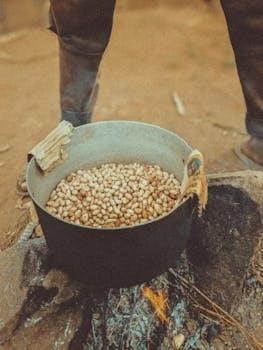
The kitchen appliance world often sees a clash between the Crock-Pot and Instant Pot, both promising convenience. This guide explores their differences, helping you choose the right tool for your cooking needs. Both devices offer unique advantages.
Understanding the Basics of Slow Cookers (Crock-Pots)
Slow cookers, often referred to by the brand name Crock-Pot, are designed for cooking food at low temperatures over extended periods. This method allows for flavors to develop deeply, and it is ideal for tenderizing tougher cuts of meat. These appliances typically feature a ceramic or stoneware insert within a metal housing. The heat is applied from the bottom and sides, ensuring even cooking. It is ideal for recipes where you add all ingredients at the start and leave to cook for several hours. Crock-pots have been a staple in kitchens for many years due to their simplicity and ability to produce delicious, hands-off meals. They are known for their low-energy consumption and ease of use.
Understanding the Basics of Multi-Cookers (Instant Pots)
Multi-cookers, popularly known as Instant Pots, are versatile kitchen appliances designed to perform multiple cooking functions. Unlike slow cookers, they use pressure cooking as their primary method, significantly reducing cooking times. Instant Pots feature a stainless steel inner pot within a sealed housing and incorporate various settings beyond pressure cooking, such as sautéing, steaming, and slow cooking. They offer precise controls, allowing for adjustments to pressure and cooking times. This appliance is known for its speed and ability to cook a wide range of dishes efficiently. Its versatility and compact design make it a popular choice for modern kitchens, and it is capable of handling many different cooking needs with just one device.

Key Differences Between Crock-Pot and Instant Pot
Crock-Pots and Instant Pots differ greatly in primary function, cooking speed, shape, and material. These distinctions significantly impact their cooking methods and results.
Primary Function⁚ Slow Cooking vs. Multi-Functionality
The core difference lies in their primary functions. A Crock-Pot, or slow cooker, is designed specifically for low-temperature, long-duration cooking, allowing flavors to meld and develop over several hours. It is a straightforward appliance focused on gentle, unattended cooking. Conversely, an Instant Pot is a multi-cooker, offering a range of functions beyond slow cooking. These functions include pressure cooking, sautéing, steaming, rice cooking, and even yogurt making. The Instant Pot’s versatility makes it a multi-purpose kitchen tool, whereas the Crock-Pot is a specialized device dedicated to slow cooking. This fundamental difference impacts recipe selection and overall kitchen needs.
Cooking Speed⁚ Time Comparison
A significant difference between Crock-Pots and Instant Pots is cooking speed. Crock-Pots are designed for slow cooking, with recipes typically requiring 4 to 8 hours on low or 2 to 4 hours on high. This extended cooking time allows for deep flavor development but requires advance planning. In contrast, an Instant Pot significantly reduces cooking time, particularly when using its pressure cooking function. Dishes that would take hours in a slow cooker can be ready in 25 to 30 minutes using an Instant Pot. This speed advantage makes the Instant Pot ideal for faster meal preparation. This difference in speed should be a key factor when making your choice.
Shape and Material Differences
Crock-Pots typically feature an oval-shaped ceramic cooking pot, which is encased in a metal housing that provides gentle heat from the bottom and sides. This design contributes to even heat distribution during slow cooking. Instant Pots, on the other hand, have a circular inner pot made of stainless steel. This pot is designed to withstand high pressure, which is used for its pressure cooking mode. The shape difference can affect how certain foods cook, and the different materials have an impact on heat transfer and moisture retention. The materials also affect the appliances’ overall durability and ease of cleaning.
Moisture Retention in Cooking
When it comes to moisture retention, there are notable differences between Crock-Pots and Instant Pots. Crock-Pots, with their gentle heating, allow moisture to slowly evaporate over the long cooking period, which can lead to a slightly drier result if not properly monitored. The Instant Pot, however, is designed to retain moisture. Because of its sealed cooking environment, especially during pressure cooking, the Instant Pot often squeezes moisture out of ingredients. This can lead to dishes that are more tender but also have a more concentrated flavor profile and less overall liquid, which is a critical difference in how the food will result.

Functionality and Features
Instant Pots boast multi-functionality including pressure cooking, steaming, and sautéing, while Crock-Pots primarily focus on slow cooking; The Instant Pot also offers yogurt making capabilities, unlike the Crock-Pot.
Instant Pot’s Multi-Function Capabilities
The Instant Pot distinguishes itself with its impressive array of functions, going far beyond simple slow cooking. It operates as a pressure cooker, significantly reducing cooking times, and also serves as a rice cooker, steamer, and warmer. Furthermore, many models include a sauté function, allowing for browning meats and vegetables directly in the pot before pressure or slow cooking. This versatility transforms the Instant Pot into a true multi-cooker, capable of handling a wide variety of recipes and cooking techniques, making it a very useful and popular kitchen appliance. Its ability to perform multiple tasks makes it a space-saving and efficient choice for many home cooks.
Crock-Pot’s Focus on Slow Cooking
The Crock-Pot, in contrast to the multi-functional Instant Pot, is primarily designed for slow cooking. Its core strength lies in its ability to gently cook food over an extended period, allowing flavors to meld and develop beautifully. This focused approach makes it ideal for recipes where low and slow cooking is key, such as stews, braises, and pot roasts. The Crock-Pot operates at a lower temperature, requiring less attention and making it a hands-off cooking solution. This makes it particularly convenient for those with busy schedules, allowing them to set it up in the morning and return to a fully cooked meal later in the day. Its simplicity is its greatest asset.
Yogurt Making Feature (Instant Pot Only)
One distinct advantage of the Instant Pot is its dedicated yogurt-making function, a feature absent in traditional Crock-Pots. This capability allows users to easily create homemade yogurt, controlling the ingredients and sweetness levels to their preference. The Instant Pot’s precise temperature control enables the consistent fermentation process needed for successful yogurt production. This feature adds a layer of versatility, allowing users to expand their culinary repertoire beyond simple meals. The yogurt-making function highlights the multi-functionality of the Instant Pot, positioning it as a more adaptable appliance for diverse culinary needs. This feature caters to health-conscious users and those who enjoy experimenting with homemade foods.

Using an Instant Pot as a Slow Cooker
Yes, an Instant Pot can function as a slow cooker, offering flexibility. However, results might differ slightly from a dedicated slow cooker due to the pot’s shape and heating method.
Can an Instant Pot Replace a Slow Cooker?
The Instant Pot does indeed offer a slow cooking function, making it a potential replacement for a dedicated slow cooker. However, it’s essential to understand that while it can perform this task, the results may vary. The Instant Pot’s heating element is located at the bottom, while a traditional slow cooker heats from the bottom and sides, which could affect cooking uniformity. Additionally, the shape of the Instant Pot, a circular steel pot, contrasts with the oval ceramic pot of many slow cookers. These design differences can lead to variations in moisture retention and cooking times. While an Instant Pot is a multi-functional appliance, true slow-cooking enthusiasts might prefer a dedicated slow cooker for optimal results, particularly with dense, high-volume recipes.
Potential Differences in Slow Cooking Results
When using an Instant Pot as a slow cooker, subtle differences in the final dish may arise compared to a traditional Crock-Pot. The heating element in an Instant Pot, primarily located at the base, can lead to less consistent heating compared to slow cookers that heat from the bottom and sides. This can sometimes result in hot spots, potentially affecting the evenness of cooking. Additionally, moisture retention might vary. While both cookers keep food moist, the Instant Pot’s sealed environment might lead to slightly different textures, especially with meats. Furthermore, recipes may need slight adjustments in cooking times and liquid levels to achieve the desired outcome when using an Instant Pot for slow cooking instead of a dedicated Crock-Pot. Dense, high-volume recipes may not cook as successfully in the Instant Pot’s slow cooker setting.
Popular Models Overview
Exploring popular models helps in decision-making. The Instant Pot Duo 7-in-1 is favored for its versatility. Crock-Pot offers various models known for reliable slow cooking. These are just some examples.
Popular Instant Pot Models (e.g., Duo 7-in-1)
The Instant Pot Duo 7-in-1 stands out as a widely loved model, celebrated for its impressive versatility and affordability. This particular model combines multiple kitchen appliances into one, functioning as a pressure cooker, slow cooker, rice cooker, steamer, sauté pan, yogurt maker, and warmer. Its user-friendly interface and various preset programs make it accessible for both beginners and experienced cooks; The Duo 7-in-1’s popularity stems from its ability to handle a wide array of cooking tasks efficiently, saving both time and counter space. It is a great example of the innovative technology the Instant Pot offers.
Popular Crock-Pot Models
Crock-Pot, as a brand, is synonymous with slow cooking, and many of their models are popular for their reliable performance. While specific model names weren’t detailed in the provided text, Crock-Pot is known for offering a range of slow cookers with varying sizes and features, catering to different family sizes and cooking needs. These models are typically characterized by their oval-shaped ceramic pots and simple controls, focusing solely on the slow cooking process. Crock-Pot models are often praised for their ability to maintain a consistent low temperature over extended periods, perfect for set-it-and-forget-it meals. They are a reliable choice for those who value the traditional slow cooking experience.

Conclusion and Recommendations
Choosing between a Crock-Pot and an Instant Pot depends on your cooking style. If you prefer slow, traditional cooking, a Crock-Pot is ideal. For versatility and speed, an Instant Pot is the better choice.
Choosing Between a Crock-Pot and an Instant Pot
Selecting between a Crock-Pot and an Instant Pot hinges on your specific culinary needs and preferences. If you prioritize the traditional slow-cooking method, where flavors meld over several hours, a dedicated Crock-Pot is your best bet. It excels at low-heat, extended cooking and is ideal for recipes requiring minimal intervention. However, if you desire a multi-functional appliance that offers speed and versatility, the Instant Pot emerges as the superior choice. Its ability to pressure cook, sauté, and even make yogurt provides a broader range of cooking options. The Instant Pot also works as a slow cooker, although it might not replicate the results of a dedicated Crock-Pot perfectly. Consider your typical cooking routine and what features would be most beneficial to you when making your decision.